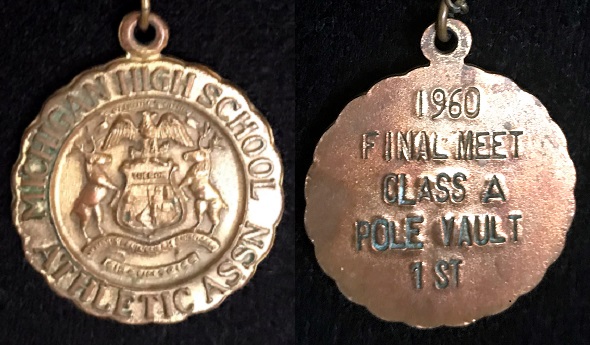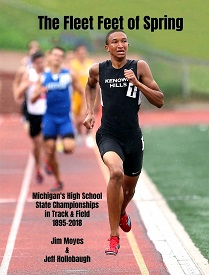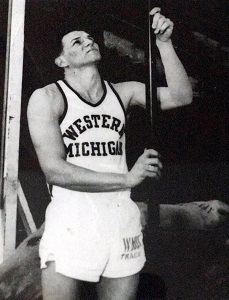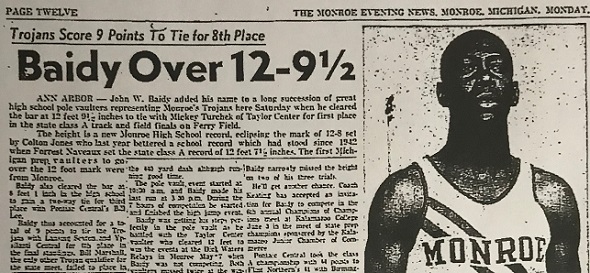
60 Years Later, Co-Champ Rediscovered
March 25, 2020
By Ron Pesch
Special for Second Half
Nicholas “Mickey” Turcheck tells a wild story. It involves a coin flip.
Involved in track & field for much of his life, Turcheck was a pole vaulter at Taylor Center during his high school days, then at Western Michigan University. He later served Taylor Center for more than three decades as track coach, where he mentored five state champions.
He also coached two future Olympians. Earl Jones, who won MHSAA Finals track titles in both 1980 and 1981, and grabbed bronze in the 800 meters at the 1984 Summer Olympics in Los Angeles. Another of his athletes, Deby LaPlante, qualified for the 1976 Summer Olympics in Montreal as a high hurdler.
In Turcheck’s possession is a medal. Etched on the back, pounded out in the style of the time, are five lines.
1960
FINAL MEET
CLASS A
POLE VAULT
1ST
Those 31 characters honor his MHSAA championship performance on what became a windy day in Ann Arbor at University of Michigan’s old Ferry Field.
But there is one problem. Turcheck’s name doesn’t appear on the MHSAA list of Finals champions. According to the list, the championship belongs to Joe Baldy of Monroe.
(The list has since been corrected and amended, per the story to be told below.)
Trackheads
For ‘trackheads’ – diehard fans of the sport and the events that comprise a track meet – as well as sports historians, a newspaper’s agate page is nirvana. Contained within the tiny type are the details that aren’t always relayed within the article covering a sporting event. Things like baseball batting averages, league standings, box scores, stat lines, team transactions, TV and radio schedules, and most everything else that doesn’t fix conveniently into the day’s sports section might appear on the page. For a track meet, a full agate listing will include place finishes as well as times, heights and distances that were used to determine winners of events, as well as detail on record performances that were equaled or topped.
Jim Moyes is a passionate sports fan. An undersized high school athlete at a small school, where participants of all shapes and sizes are valued, Moyes was the son of a prep coach at North Muskegon High School. He grew up and became, among other things, a beloved and respected broadcaster and public address announcer. Few were as well-prepared as Moyes, who studied agate pages, past performances, and, it seemed, the family trees of the participants prior to sitting before a microphone. His knowledge, as well as his sense of humor, was on display for 43 years in West Michigan, where he would balance his understanding and importance of an event with the awareness that, in the end, what we were experiencing was still just a game.
 Well over 30 years ago he began his research into a passion project. Moyes is a ‘trackhead.’ And, because of this, in 2019, he officially became the author of a published book.
Well over 30 years ago he began his research into a passion project. Moyes is a ‘trackhead.’ And, because of this, in 2019, he officially became the author of a published book.
Way back, Moyes began digging into microfilm with the goal of capturing the names and events behind each MHSAA Finals track championship. He shared his initial research with the MHSAA, and for years the Association has highlighted his work on its website with lists of individual state champions on both their boys and girls track pages.
A couple of years before wrapping up his research, Moyes began work with another certified ‘trackhead,’ Jeff Hollobaugh – associated editor of Track & Field News, the voice of countless track meets, and as Moyes states, an “expert on this great sport” – to tell the stories of the meets in book form. “The Fleet Feet of Spring” – a history of Michigan’s High School State Championships covering the span 1895-2018 – was the result.
That’s 24,446 state champions. Simply put, its 439 pages contain a marvelous collection of statistics, stories and images.
But, with good reason, Turcheck’s name doesn’t appear in the publication.
Golden Age of Newspapers
Post-event press coverage on the 1960 MHSAA State Track Meet for most readers across Michigan arrived in their newspaper courtesy of coverage by wire-service reporters from The Associated Press or United Press International. With four meets to cover that encompass hundreds of prep athletes, the arch of the stories generally focus on record-setting events and streaks of success.
In Class A, the story was focused on the Pontiac Central squad that slipped past Flint Northern, 44-41, for its fifth title in six years. It was the seventh year in a row that the Vikings finished second at the meet. Pontiac junior Bredell Pritchett’s 59-foot-5¾ toss of the shot exceeded the previous state mark by better than two feet. Northern’s Maurice Pea, clocked at 9.8 seconds, tied a 35-year-old mark in the 100-yard dash. Al Ammerman of Dearborn established a new high jump record.
In 1960, the details of the pole vault simply weren’t the story.
Available space in newspapers is dictated by advertising. That certainly is the case today, and was most certainly the case back in the glory days of newsprint. Decisions are made by sports editors and staff on the amount of space available, and what agate will be printed. The results of a track meet, let alone the four simultaneous meets that comprise the MHSAA state championships, can certainly eat up plenty of real estate.
Relatively few papers around Michigan dedicated space to the MHSAA Track Championships back in May 1960. The old Detroit Times is among those that did include agate. Study of the listing however provides little clarity, as the paper listed only Metro Detroit finishers beyond the event winners. For the pole vault, that means confusion.
Pole Vault – “1 Joe Baldy, Monroe: Mickey Turcheck. Taylor Center: Bob Davis. Redford Union. and Larry Richardson. Livonia Bentley. were among those tieing for fourth. Distance 12 feet, 9 inches.”
The Grand Rapids Press agate adds haze to the mix. Baldy is listed in first, but Turcheck is listed as finishing second, followed by Flint Northern’s Jerry Wright in third. Davis, Richardson, Mike Pedler of Muskegon, J. Best from Battle Creek Central and Bill King of Traverse City are listed as occupying fourth place
The Battle Creek Enquirer lists only Baldy as the winner of the event and John Best “tied for fourth.” The Lansing State Journal agate shows only Baldy as the event winner. No track agate appears in the Detroit Free Press. Although the paper notes that team-wise, Birmingham finished third with 18 points, followed by Dearborn, Ann Arbor, Muskegon and Saginaw Arthur Hill in its coverage, the results from the Class A pole vault are not mentioned.
The Traverse City Record-Eagle does not include agate, but the article notes King’s fourth place finish, and that the Trojans track team spent the night sleeping on tumbling mats in the Saginaw Arthur Hill gymnasium when its bus broke down on the return trip home from Ann Arbor.
So, with little surprise, Moyes’ research concluded Baldy was the 1960 Class A pole vault champion.
Story of the Medal
In early March, Tony Mifsud, a longtime track coach at Dearborn Divine Child, contacted MHSAA Director of Broadcast Properties John Johnson about the story.

Turcheck was recently visiting a friend, Bob Parks, the head track coach at Eastern Michigan University for 34 years and an assistant track coach at Western Michigan during Turcheck’s time in Kalamazoo competing for the Broncos. On a visit this past fall, Parks mentioned the Moyes and Hollobaugh book that he had recently received.
“Mick, your name is not listed there,” said Parks. “I know you were tied for the state championship because I was the coach at Redford Thurston at that time and I was at the state meet. I remember you being announced as the co-state champion of the pole vault.”
“I said, ‘Really?’” recalled Turcheck from his home in Taylor.
After the visit, he made a couple of phone calls to friends. In turn, some of those folks began reaching out to others with the story.
According to Turcheck, after the pole vault was over, a meet official said they only had one medal and they were going to flip to determine who would receive it. Turcheck won the coin flip and was awarded the souvenir. A duplicate medal was to be mailed to his co-champion.
Newsprint and the Miracle of Microfilm
Before the days of smartphones, e-mail, websites, pop-up ads, and cloud storage, the history of cities, big and small, was captured in print and sold on street corners, at newsstands, and, beginning in 1947, by coin-operated vending machines.
Monthly subscriptions meant home delivery of the day’s news, and newspapers were everywhere.
Before Craigslist and Google Ads, there was money to be made in helping businesses advertise their wares, employers to advertise job openings, and for individuals to sell items and offer apartments for rent in the classifieds. That strong revenue stream supported large staffs and solid coverage of local events at daily and weekly newspapers.
Some of that content – that history – is slowly coming online, but most of it remains tucked away on microfilm and microfiche in local libraries across America.
And sometimes, local pride resulted in details about the exploits and accomplishments of area athletes to appear in smaller town publications that cannot be found elsewhere.
Niles Kruger, a sportswriter at the Monroe Evening News, followed up on a request by Johnson to check microfilm from newspapers in the area for any detail that might exist. Fortunately, the coverage in the Evening News appears to help clear up much of the story.
The article also illustrates an issue often injected upon microfilm by small agate-style typeface. Characters can often bleed or blur and appear to be other letters. A lower case ‘s’ can look like an ‘a’ or an ‘e’; a lower case ‘i’ can look like lower case ‘l.’ Unexpectedly, this, too, was illustrated here.
And sometimes, long lists are subject to other errors.

‘Baidy’ not ‘Baldy, ‘John’, not ‘Joe’
“ANN ARBOR - John W. Baidy added his name to a long succession of great high school pole vaulters representing Monroe’s Trojans here Saturday,” stated the Evening News, “when he cleared the bar at 12 feet 9 ½ inches to tie with Mickey Turcheck of Taylor Center for first place in the state Class A track and field finals on Ferry Field …”
“Baidy also cleared the bar at 6 feet 1 inch in the high (jump) to gain a two-way tie for third place with Pontiac Central’s Bill Lee. Baidy thus accounted for a total of 9 points to tie the Trojans with Lansing Sexton and Ypsilanti Central for 8th place in the final standings.”
While there is no mention of the flip for the metal, the article backs up Turcheck’s recall of the day.
Recognizing that despite their best efforts, Moyes and Hollobaugh know that errors can appear in the publication. In their “Notes to the reader” section, they ask readers to please make contact if any mistakes are spotted.
“Thanks to today's modern technology Jeff Hollobaugh will be able to make the appropriate corrections in our book” noted Moyes from Florida via email, noting the marvels of the times we live in. “Better yet for Jeff & I,” added Moyes, displaying his comedic style, “with the amended corrections maybe Mickey Turcheck will purchase our newly revised book.”
Search for Baidy
“They wanted to flip a coin,” said Baidy recently, surprised in the sudden interest in a day from so many years ago and chuckling at the memory. “He got the call and got the medal. I really don’t remember if they told me if I was supposed to get a medal (in the mail). Right after that I had to go to the high jump or something.”
Baidy – who also tied for the Class A Finals high jump championship in 1959 – had received a call earlier on this day from his long-ago opponent from Taylor Center.
“I would certainly like to meet him again,” said Turcheck. His former high school sweetheart and bride had used her smartphone to seek out Baidy’s contact information, and soon after, the two old athletes were reminiscing about the day. Turcheck pitched the idea of getting together for lunch or dinner sometime soon.
“That’s what he wants to do, and it’s all right with me,” Baidy said, noting plans after things settle down. “We’re lucky to still be alive.”
 Ron Pesch has taken an active role in researching the history of MHSAA events since 1985 and began writing for MHSAA Finals programs in 1986, adding additional features and "flashbacks" in 1992. He inherited the title of MHSAA historian from the late Dick Kishpaugh following the 1993-94 school year, and resides in Muskegon. Contact him at [email protected]:void(0);t with ideas for historical articles.
Ron Pesch has taken an active role in researching the history of MHSAA events since 1985 and began writing for MHSAA Finals programs in 1986, adding additional features and "flashbacks" in 1992. He inherited the title of MHSAA historian from the late Dick Kishpaugh following the 1993-94 school year, and resides in Muskegon. Contact him at [email protected]:void(0);t with ideas for historical articles.
PHOTOS: (Top) The 1960 Finals championship medal, front and back, awarded to Baidy. (2) The Fleet Feet of Spring has been revised based on the latest re-discovery of a co-championship. (3) Mickey Turchek went on to compete at Western Michigan. (4) The Monroe Evening News announced John Baidy’s championship pole vault as part of its coverage of the 1960 Class A Track & Field Finals. (Turchek photo courtesy of the Turcheck famly; newspaper clipping courtesy of the Monroe Evening News.)

Standout Dunn Does it All for Saugatuck
April 22, 2016
By Dave Sontag
Reprinted from Prep Baseball Report
At times, he wears a uniform under his uniform.
The attire that rests inside his baseball jersey has an “S” on the chest. The “S” should stand for Superman. For Saugatuck multi-athlete Blake Dunn, he doesn’t think playing four varsity sports each school year is newsworthy.
“Personally, I have never wanted to give up on any sports. I have the support from all of the coaches. I never wanted to close the door to any of the sports,” Dunn said.
The talented junior is currently competing on his school’s baseball and track & field teams. He hopes to end his high school career earning 16 varsity letters, an unprecedented feat in Saugatuck history.
Dunn has been the starting quarterback for three years and starred on the basketball court for three winters. In an age when many high school athletes prefer to specialize in one sport, Dunn has a different attitude.
“High school only happens once,” Dunn said. “My parents are behind me and my coaches all support me.”
So how does Dunn prepare for each of his spring sports?
Track coach Rick Bauer allows Dunn to conduct his workouts in the morning – before school. Baseball coach Dave Gawlak then works with Dunn after school on the diamond. Game and meet conflicts are minimal during the spring sports season.
It helps that Saugatuck’s athletic director is Bill Dunn, Blake’s dad. The veteran AD has not scheduled many events when baseball and track are competing on the same day. However, Blake did have to make a decision his freshman year when both the track and baseball teams traveled to Bloomingdale High School on the same day.
Blake said that day at Bloomingdale was the most memorable he has had during his high school career.
“I started off playing baseball that day and singled in my first at bat,” Dunn said. “I then changed into my track uniform and won three straight events.”
Dunn won the 110-meter hurdles, the 300 hurdles and as part of the 800 relay before changing back into his baseball uniform.
With the “S” etched on his chest, how did Dunn cap his full day of competition?
“I went back to the baseball field and hit a home run in my next at bat,” Dunn said.
Dunn not only intends to earn 16 varsity letters in his high school career, he also has earned all-state recognition in all four sports. He’s also recently been added to the MHSAA football record book for his accomplishments this past season.
Which sport does he like the best?
“I love them all so much. I really don’t know which one is my favorite,” Dunn said.
As an elementary student, Blake grew up on the gridiron with his dad, who is also Saugatuck’s football coach. Being a coach’s son, Blake serves as another coach on the field.
“He’s always hung around the field,” Bill Dunn said. “Ever since second or third grade, Blake has been around me on the football field.”
The 5-foot-11, 180-pounder said there is nothing like “the Friday night lights in football and the Friday night crowds in basketball.”
“I have limited opportunities to play sports. I don’t want to miss out on any of them,” Blake Dunn said.
Demonstrating talent on the basketball court, Dunn scored 51 points against Lawton this winter. He finished his junior year with more than 1,000 career points.
Dunn’s offseason schedule consists of playing travel baseball and working out with the school’s basketball and football teams.
“I don’t wear myself out playing one sport and possibly getting hurt,” Dunn said.
 Dunn does realize that college coaches encourage athletes to play multiple sports. In fact, statistics have proven that high school athletes who specialize in one sport are at an increased risk of injuries – especially knee and hip injuries.
Dunn does realize that college coaches encourage athletes to play multiple sports. In fact, statistics have proven that high school athletes who specialize in one sport are at an increased risk of injuries – especially knee and hip injuries.
David Bell, a professor of kinesiology and orthopedics and rehabilitation at University of Wisconsin, said after his school completed its recent study “Prevalence of Sport Specialization in High School Athletics” that parents need to be more cognizant of their children specializing in one sport.
Athletes who trained in one sport for more than eight months during the study were more likely to have a history of knee and hip injuries, Bell reported.
The MHSAA also is currently spearheading a task force to promote multi-sport participation.
“For years it seemed educators were alone in promoting the multi-sport experience as the best for young people,” Executive Director Jack Roberts said. “Major college football coaches, members of the USA Women’s World Cup Soccer championship team, Hall of Fame pitcher John Smoltz, PGA golfer Jordan Spieth and others demonstrate to us that the multi-sport experience is the healthiest and happiest way to participate in youth sports.”
While playing four sports has kept Dunn busy athletically, he has been able to keep his grades solid. He holds a 3.95 grade-point average with a rigorous schedule.
The two-way baseball player has made a verbal commitment to play at Western Michigan University after high school. He is not sure if he will continue at WMU on the mound or as a catcher – or both.
“They have talked to me about maybe catching and then closing on the mound,” Dunn said.
Staying close to home does not surprise his dad.
“He’s really a down-home kid,” Bill Dunn said of his son. “The relationship with Billy (Gernon, WMU’s coach) is awesome.
The elder Dunn is proud of his son’s work ethic.
“He has God-given skills, but he works at it.” Bill said. “I remember him coming off of a basketball game on a Friday night and heading to Kalamazoo the next morning at 6:30 to work out for three hours.”
The talented junior has been clocked pitching at 90 mph and ran a 6.7-second 60-yard dash.
The script for Dunn has been storybook-like. Peeling off one uniform only to compete in another sport, he has carved quite an athletic career.
But while Western Michigan is waiting for the multi-talented athlete to finish high school, Blake will continue doing what he does best – performing at the highest level on his way to 16 varsity letters.
PHOTOS: (Top) Dunn has starred in football, basketball and baseball during the 2016-17 school year. (Middle) Dunn also was a Lower Peninsula Division 4 champion last spring in the 300 hurdles and as part of the 1,600 relay. (Top photos courtesy of the Dunn family, middle photo by RunMichigan.com.)

